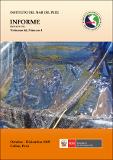Por favor, use este identificador para citar o enlazar este ítem:
https://hdl.handle.net/20.500.12958/3382Registro completo de metadatos
| Campo DC | Valor | Lengua/Idioma |
|---|---|---|
| dc.contributor.author | Tejada Cáceres, Alex | - |
| dc.contributor.author | Baldarrago, Danny | - |
| dc.contributor.author | Aragón, Beatriz | - |
| dc.contributor.author | Vizcarra, Yhordan | - |
| dc.contributor.author | Villanueva, Javier | - |
| dc.contributor.editor | Instituto del Mar del Perú | - |
| dc.date.accessioned | 2019-12-24T14:47:12Z | - |
| dc.date.available | 2019-12-24T14:47:12Z | - |
| dc.date.issued | 2019 | - |
| dc.identifier.citation | Inf Inst Mar Perú 46(4), 2019, p.557-577 | es_ES |
| dc.identifier.issn | 0378-7702 | - |
| dc.identifier.uri | https://hdl.handle.net/20.500.12958/3382 | - |
| dc.description.abstract | Se realizaron muestreos durante el 2017 en diferentes zonas de extracción del litoral de las Regiones Moquegua y Tacna, determinándose el estado poblacional del Concholepas concholepas “chanque” y de algunos aspectos biológico pesqueros. Las zonas monitoreadas se caracterizaron por ser de fondo duro y estar cubiertas principalmente por mantos del mitílido Semimytilus algosus y del tunicado Pyura chilensis. Santa Rosa y Meca ubicadas en el litoral de Tacna presentaron mayores abundancias relativas de C. concholepas, con moda principal entre 45 mm (marzo) y 57 mm (noviembre); mientras que en Ilo (Moquegua) destacaron Fundición y Punta Coles. La población está compuesta, en su mayoría, por individuos menores a la talla mínima de captura, en la pesquería la longitud media varió entre 47,6 y 70,6 mm en Ilo, en Morro Sama varió entre 49,8 y 59,5 mm. El comportamiento reproductivo del chanque, indica que desovó durante todo el año 2017, registrándose mayor intensidad en noviembre. El volumen desembarcado fue de 31,3 t, habiendo incrementado en relación al 2016. Los recursos Fissurella latimarginata “lapa negra” y Loxechinus albus “erizo verde” son especies explotadas frecuentemente, registrándose disminución de sus poblaciones, y alta presencia de individuos menores a la talla mínima de captura. | es_ES |
| dc.description.abstract | ABSTRACT: In 2017, samples were taken in different coastal extraction zones in the Moquegua and Tacna Regions, determining the population status of Concholepas concholepas “false abalone” and some biological and fisheries aspects. The monitored areas were characterized as hard bottom and were covered mainly by mantles of the mitylid Semimytilus algosus and the tunicate Pyura chilensis. Santa Rosa and Meca located on the Tacna coast presented greater relative abundances of C. concholepas, with main mode between 45 mm (March) and 57 mm (November); while Foundry and Punta Coles stood out in Ilo (Moquegua). The population is composed mostly of individuals smaller than the minimum catch size. In the fisheries, the mean length varied between 47.6 and 70.6 mm in Ilo; in Morro Sama, it ranged between 49.8 and 59.5 mm. The reproductive behavior of the false abalone indicates that it spawned throughout 2017, with greater intensity in November. The landed volume was 31.3 t, which is an increase compared to 2016. The resources Fissurella latimarginata “Peerski’s companion” and Loxechinus albus “red sea urchin” are frequently exploited species, with declining populations and a high presence of individuals smaller than the minimum catch size. | - |
| dc.language.iso | spa | es_ES |
| dc.publisher | Instituto del Mar del Perú | es_ES |
| dc.relation.ispartofseries | Informe IMARPE;46(4), 2019 | - |
| dc.rights | info:eu-repo/semantics/openAccess | es_ES |
| dc.rights.uri | https://creativecommons.org/licenses/by/4.0/ | es_ES |
| dc.source | Instituto del Mar del Perú - IMARPE | es_ES |
| dc.source.uri | Repositorio Digital IMARPE | es_ES |
| dc.subject | Concholepas concholepas (Brugiere) | es_ES |
| dc.subject | “chanque | es_ES |
| dc.subject | Indicadores biológico-poblacionales | es_ES |
| dc.subject | Moquegua | es_ES |
| dc.subject | Tacna | es_ES |
| dc.title | El chanque (Concholepas concholepas (B.)) en el litoral de las regiones Moquegua y Tacna, 2017 | es_ES |
| dc.title.alternative | False abalone (Concholepas concholepas (B.)) in the coast of the Moquegua and Tacna Regions, 2017 | es_ES |
| dc.type | info:eu-repo/semantics/article | es_ES |
| Aparece en las colecciones: | Informe vol. 46(4) 2019 | |
Ficheros en este ítem:
| Fichero | Descripción | Tamaño | Formato | |
|---|---|---|---|---|
| Informe 46(4)-4.pdf | 2,95 MB | Adobe PDF |  Visualizar/Abrir |
Este ítem está sujeto a una licencia Creative Commons Licencia Creative Commons

